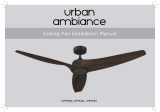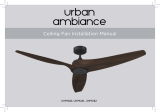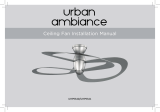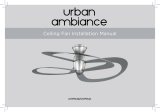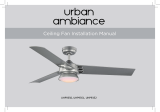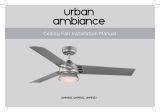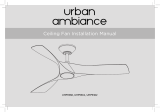
Ceiling Fan Installation Manual
P2596
93099661_A

Date Purchased
Store Purchased
Model No.
Serial No.
Vendor No.
UPC
109226
785247000000
785247000000
785247000000
Limited Lifetime Warranty
Progress Lighting fan motors are warranted to the original purchaser to be free of electrical and/or mechanical defects for so
long as the original purchaser owns the fan. Pull chain switches, reverse switches, capacitors and metal finishes are warranted to
be free from defects in materials or workmanship for a period of 1 year from the date of purchase. Warping of wooden or plastic
blades is not covered by this warranty nor is corrosion and/or deterioration of any finishes for fans installed within ten miles of
any sea coast. Extended warranties for ENERGY STAR
®
qualified products may apply.
Progress Lighting ceiling fans with built-in LED light sources, when properly installed and under normal conditions of use, are
warranted to be free from defects in material and workmanship which cause the light sources to fail to operate in accordance
with the specifications for (i) five (5) years from the date of purchase on the LED Light modules and electrical components for
fans used in single family residences, and (ii) three (3) years from the date of purchase on the LED Light modules and electrical
components for fans used in multi-family or commercial applications. LED bulbs supplied by Progress Lighting carry no
warranty other than manufacturer’s warranty. Non-LED bulbs carry no warranty.
With proof of purchase, the original purchaser may return the defective fan to the place of purchase during the first 30 days for
replacement. After 30 days, the original purchaser MUST contact Progress Lighting at (864) 678-1000 for repair or replacement
which shall be determined in Progress Lighting’s sole discretion and shall be purchaser’s sole and exclusive remedy.
Labor and Shipping Excluded. This warranty does not cover any costs or fees associated with the labor (including, but not
limited to, electrician’s fees) required to install, remove, or replace a fan or any fan parts.
This warranty shall not apply to any loss or damage resulting from (i) normal wear and tear or alteration, misuse, abuse or
neglect, or (ii) improper installation, operation, repair or maintenance by original purchaser or a third party, including without
limitation improper voltage supply or power surge, use of improper parts or accessories, unauthorized repair (made or
attempted) or failure to provide maintenance to the fan.
THE FOREGOING WARRANTIES STATE PROGRESS LIGHTING’S ENTIRE WARRANTY OBLIGATION AND
ORIGINAL PURCHASER’S SOLE AND EXCLUSIVE REMEDY RELATED TO SUCH PRODUCTS. PROGRESS
LIGHTING IS NOT RESPONSIBLE FOR DAMAGES (INCLUDING INDIRECT, SPECIAL, INCIDENTIAL OR
CONSEQUENTIAL), DUE TO PRODUCT FAILURE, WHETHER ARISING OUT OF BREACH OF WARRANTY,
BREACH OF CONTRACT, OR OTHERWISE. THIS WARRANTY IS GIVEN IN LIEU OF ALL OTHER WARRANTIES,
WHETHER EXPRESSED OR IMPLIED, INCLUDING THOSE OF MERCHANTABILITY, FITNESS FOR A PARTICULAR
PURPOSE OR NONINFRINGEMENT.
Some states do not allow limitations on how long an implied warranty lasts or the exclusion or limitations of incidental or
consequential damages, so the above limitations and exclusions may not apply to you. This warranty gives you specific rights
and you may have other rights which vary from state to state.

Table of Contents
Safety Rules.....................................................................................................................................................................................
Unpacking Your Fan .......................................................................................................................................................................
Installing Your Fan ..........................................................................................................................................................................
Installing the Light Kit.....................................................................................................................................................................
Operating Your Transmitter ...........................................................................................................................................................
Care of Your Fan ...........................................................................................................................................................................
Troubleshooting ............................................................................................................................................................................
Specifications ................................................................................................................................................................................
1.
2.
3.
8.
10.
12.
13.
14.

1. Safety Rules
1. To reduce the risk of electric shock, insure electricity has been turned off
at the circuit breaker or fuse box before beginning.
2. All wiring must be in accordance with the National Electrical Code and
local electrical codes. Electrical installation should be performed by a
qualified licensed electrician.
3. WARNING: To reduce the risk of electrical shock and fire, do not use
this fan with any solid-state fan speed control device.
4. WARNING: To reduce the risk of fire, electric shock, or personal injury,
mount to outlet box marked "Acceptable for Fan Support of 15.9 kg (35 lbs.)
Or Less" and use mounting screws provided with the outlet box. Most outlet
boxes commonly used for the support of light fixtures are not acceptable for
fan support and may need to be replaced. Due to the complexity of the
installation of this fan, a qualified licensed electrician is strongly
recommended.
WARNING
TO REDUCE THE RISK OF FIRE, ELECTRIC SHOCK OR PERSONAL
INJURY, MOUNT FAN TO OUTLET BOX MARKED ACCEPTABLE FOR
FAN SUPPORT.
5. The outlet box and support structure must be securely mounted and
capable of reliably supporting a minimum of 35 lbs (15.9 kg) or less.
Use only UL-listed outlet boxes marked FOR FAN SUPPORT.
6. The fan must be mounted with a minimum of 7 ft (2.1m) clearance from
the trailing edge of the blades to the floor.
7. Avoid placing objects in the path of the blades.
8. To avoid personal injury or damage to the fan and other items, be
cautious when working around or cleaning the fan.
9. Do not use water or detergents when cleaning the fan or fan blades. A
dry dust cloth or lightly dampened cloth will be suitable for most
cleaning.
10. After making electrical connections, spliced conductors should be
turned upward and pushed carefully up into the outlet box. The wires
should be spread apart with the grounded conductor and the
equipment-grounding conductor on one side of the outlet box.
11. Electrical diagrams are for reference only. Light kits that are not packed
with the fan must be UL Listed and marked suitable for use with the
model fan you are installing. Switches must be UL General Use
Switches. Refer to the Instructions packaged with the light kits
NOTE
READ AND SAVE ALL INSTRUCTIONS!
WARNING
TO REDUCE THE RISK OF PERSONAL INJURY, DO NOT BEND THE
BLADE ARMS (ALSO REFERRED TO AS BRACKETS) DURING
ASSEMBLY OR AFTER INSTALLATION. DO NOT INSERT OBJECTS IN
THE PATH OF THE BLADES.

Unpack your fan and check the contents. You should have the following items:
Unpacking Your Fan 2.
14. Loose parts bag containing:
a. Blade attachment hardware
9 screws
b. Mounting hardware
Wire nuts (3)
1. Fan blades (2)
2. Blade support plate with aid screws (2)
3. Blade support plate (2)
4. Canopy assembly
5. Ball/downrod assembly
6. Coupling cover
7. Fan motor assembly
8. Mounting plate
9. 18-Watt LED light kit
10. Glass shade
11. Receiver with 6 wire nuts
12. Transmitter assembly
13. Balancing kit
3
1
2
8
9
4
5
6
7
10
13
12
14
a
b
11

Tools Required
Phillips screw driver, straight slot screw driver,
adjustable wrench, step ladder, and wire cutters.
Mounting Options
If there isn't an existing UL listed mounting box,
then read the following instructions. Disconnect
the power by removing fuses or turning off
circuit breakers.
Secure the outlet box directly to the building
structure. Use appropriate fasteners and building
materials. The outlet box and its support must be
able to fully support the moving weight of the
fan (at least 35 lbs). Do not use plastic outlet
boxes.
3. Installing Your Fan
WARNING
TO REDUCE THE RISK OF FIRE, ELECTRIC
SHOCK, OR OTHER PERSONAL INJURY,
MOUNT FAN ONLY TO AN OUTLET BOX
MARKED ACCEPTABLE FOR FAN SUPPORT
AND USE THE MOUNTING SCREWS
PROVIDED WITH THE OUTLET BOX. OUTLET
BOXES COMMONLY USED FOR THE
SUPPORT OF LIGHTING FIXTURES MAY NOT
BE ACCEPTABLE FOR FAN SUPPORT AND
MAY NEED TO BE REPLACED. CONSULT A
QUALIFIED ELECTRICIAN IF IN DOUBT.
Figure
1
Figure
3
Figure
4
Figure
2
Outlet box
Outlet box
Outlet box
Note: You may need a longer downrod to
maintain proper blade clearance when installing
on a steep, sloped ceiling.
To hang your fan where there is an existing
fixture but no ceiling joist, you may need an
installation hanger bar as shown in Figure 4
(available at your Progress Lighting Retailer).
Angled ceiling
maximum
18.5 angle
Recessed
outlet box
Provide strong support
Ceiling
hanger
bracket

4.
Attaching the Fan Blades
Step 1.
Remove the motor top cover by removing
the six screws with lock washers from the
motor collar. (Fig. 5)
Step 2. Insert the blade assembly through the two
holes in the motor housing. Carefully insert blade
support plate with aid screw to blade arm on top
of the motor. Align the holes in the blade support
plate, blade arm and the fan motor assembly and
secure with 2 screw provided. (Fig. 6)
Step 3. Fasten the blade support plate to bottom
blade arm with 2 screw provided. Tighten screws
securely. (Fig. 6)
Step 4.
Remove the aid screws. You can keep
the aid screws for future use. (Fig. 7)
Step 5.
Place the motor cover over the motor.
Align the mounting holes with the holes in the
motor and fasten using the six screws with
lock washers previously removed. (Fig. 7)
Figure 6
Screws
Blade support
plate with aid screw
Blade arm
Screws
Blade support
plate
Figure 5
Screws
Top of
motor
cover
Motor
Coupling
Figure 7
Remove
aid screws
Screws
Top of
motor
cover
Coupling

5.
Hanging the Fan
REMEMBER to turn off the power. Follow
the steps below to hang your fan properly:
Step 1. Remove the decorative canopy bottom
cover from the canopy by turning the cover
counter clockwise.(Fig. 8)
Step 2. Remove the mounting bracket from
the canopy by removing the 1 of 2 screws
from the bottom of the mounting bracket and
loosening the other one a half turn from the
screw head. Next, turn the canopy counter
clockwise to removing the mounting bracket
from the canopy. (Fig. 8)
Step 3. Pass the 120-volt supply wires
through the center hole in the ceiling hanger
bracket as shown in Fig. 9.
Step 4. Secure the hanger bracket to the
ceiling outlet box with the screws and
washers provided with your outlet box.
Step 5. Remove the hanger pin, lock pin and
set screws from the top of the motor
assembly. (Fig. 10)
Step 6. Route wires exiting from the top of
the fan motor through the collar cover,
canopy cover, canopy and then through the
ball / downrod. (Fig. 10)
Step 7. Align the holes at the bottom of the downrod
with the holes in the collar on top of the motor
housing (Fig. 10). Carefully insert the hanger pin
through the holes in the collar and downrod. Be
careful not to jam the pin against the wiring inside the
downrod. Insert the locking pin through the hole near
the end of the hanger pin until it snaps into its locked
position, as noted in the circle inset of Fig. 10.
WARNING
FAILURE TO PROPERLY INSTALL
LOCKING PIN AS NOTED IN STEP 7
COULD RESULT IN FAN LOOSENING AND
POSSIBLY FALLING.
Figure 8
Figure 9
Figure 10
Ceiling hanger
bracket
Ceiling
canopy
Canopy
cover
Ceiling
hanger
bracket
Mounting screws
(supplied with
electrical box)
UL Listed
electrical
box
120V Wires
Washers
Supply wires
Downrod
Hanger pin
Lock pin
Set screws
Canopy
Canopy cover
Collar cover
Pin in locked
position
Step 8. Tighten two set screws on top of the fan
motor firmly. (Fig. 10)
Step 9. Place the downrod ball into the hanger
bracket socket.

6.
Make the Electric
Connections
WARNING: To avoid possible electrical shock,
be sure electricity is turned off at the main fuse box
before wiring.
NOTE: This remote control unit is equipped with
16 code combinations to prevent possible
interference from or to other remote units. The
frequency switches on your receiver and
transmitter have been preset at the factory. Please
recheck to make sure the switches on the
transmitter and the receiver are set to the same
position, any combination of settings will operate
the fan as long as the transmitter and receiver are
set to the same position. (Fig. 11)
Step 1. (Fig. 12) Insert the receiver into the
mounting bracket with the flat side of the receiver
facing the ceiling.
Step 2. (Fig. 13) Motor to Receiver Electrical
Connections: Connect the Black wire from the fan
to Black wire marked "TO MOTOR L". Connect
the White wire from the fan to the White wire
marked "TO MOTOR N" from the receiver.
Connect the Blue wire from the fan to the Blue
wire marked "For Light" from the receiver. Secure
wire connections with the plastic wire nuts
provided.
Step 3. (Fig. 13) Receiver to House Supply Wires
Electrical Connections: Connect the black (hot)
wire from the ceiling to the black wire marked
"AC in L" from the receiver. Connect the white
(neutral) wire from the ceiling to the white wire
marked "AC in N" from the Receiver. Secure the
wire connections with the plastic wire nuts
provided.
Step 4. (Fig. 13) If your outlet box has a ground
wire (green or bare copper) connect it to the fan
ground wires; otherwise connect the hanging
bracket ground wire to the mounting bracket.
Secure the wire connection with a plastic nut
provided. After connecting the wires spread them
apart so that the green and white wires are on one
side of the outlet box and black and blue wires are
on he other side. Carefully tuck the wire
connections up into the outlet box.
NOTE: Fan must be installed at a maximum
distance of 20 feet or less from the transmitting
unit for proper signal transmission between
the transmitting unit and the fan's receiving unit.
Figure 12
Receiver
Hanger
bracket
Figure 11
Code switch

Outlet box
Canopy cover
Canopy
Hanger
bracket
Figure 14
Screws
7.
Figure 13
Finishing the Installation
Step 1. Tuck connections neatly into ceiling outlet
box.
Step 2. Slide the canopy up to mounting bracket and
place the key hole on the canopy over the screw on
the mounting bracket, turn canopy until it locks in
place at the narrow section of the key holes. (Fig.
14)
Step 3. Align the circular hole on canopy with the
remaining hole on the mounting bracket, secure by
tightening the two set screws. Note: Adjust the
canopy screws as necessary until the canopy and
canopy cover are snug.
WARNING
Make sure the notch on the hanging bracket properly
sits in the groove in the hanger ball before attaching
the canopy to the bracket by turning the housing until
it drops into place.
White (neutral)
Green or bare
copper (ground)
White ("AC IN N")
Outlet box
Black (hot)
Black ("AC IN L")
Receiver
White (neutral)
White
("to motor N")
Ground (green)
(Connect to ground
wire on hanger bracket
if no house ground wire
exists.)
Black ("to motor L")
Blue (for light)
Blue (for light)
Black (motor)

Installing the Light Kit
8.
Figure 15
Installing the Mounting
Plate
Step 1.
Remove 1 of the 3 screws from the
mounting ring and loosen the other 2 screws.
(Do not remove)
Step 2.
Place the key holes on the mounting
plate over the 2 screws previously loosened from
the mounting ring, turn mounting plate until it
locks in place at the narrow section of the key
holes. Secure by tightening the 2 screws
previously loosened and the one previously
removed. (Fig. 15)
Mounting plate
Mounting ring
Screws
CAUTION: Before starting installation,
disconnect the power by turning off the circuit
breaker or removing the fuse at fuse box. Turning
power off using the fan switch is not sufficient to
prevent electric shock.
1. Remove 1 of 3 screws from the mounting plate
and loosen the other 2 screws. (Do not remove)
2. While holding the LED light kit under the fan
motor assembly, make the 2-pin wire connections:
- White to white
- Black to blue
3. Place the key holes in the LED light kit over
the two mounting screws previously loosened
from the mounting plate. Turn the LED light kit
until the LED light kit locks in place at the
narrow section of the key holes. Secure by
tightening the two screws previously loosened
and the one previously removed. (Fig. 16)
4. Raise the glass shade up against the LED light
kit and secure it to the fan by turning the glass
shade clockwise until snug. DO NOT
OVERTIGHTEN. (Fig. 16)
Figure 16
Screws
Glass
shade
Mounting
plate
Wire connector
LED
Light kit

9.
Installing the Transmitter
Holder
Select a location to install your remote control
system transmitter. You can replace an existing
wall switch or, install the transmitter on ANY
flat surface.
Option 1:
Install the remote control system
using an existing wall switch outlet box. Make
sure the electrical power is TURNED OFF
at
the main panel before continuing.
Step 1.
Remove the existing wall plate and the
old switch from the wall outlet box. Wire nut the
BLACK leads (hot) together and push back
inside the outlet box. (Fig. 17)
Step 2.
Install the metal plate and holder to the
existing wall outlet box with 4 screws provided.
(Fig. 18)
Option 2:
Install the control system on ANY flat
surface.
Select the desired location and use the holder to
mark the location for the mounting holes. Plastic
wall anchors and screws are provided for this
type of installation. After installing the wall
anchors, attached the holder with the mounting
screws. (Fig. 19)
Figure 19
Figure 17
Figure 18
Wall plate
Switch
Outlet box
Screws
Screws
Holder
Outlet box
Metal plate
Holder
Wall
Screws
Plastic
anchor

Operating Your Transmitter
10.
Installing the battery
Remove the back cover on the transmitter and
install both, 3 volt (#2032) batteries that were
included with the remote control. Make sure the
+ sign is facing up.
Figure 20
The Reverse switch is located on the motor
housing. Slide the switch to the Left for warm
weather operation. Slide the switch to the Right
for cool weather operation.
NOTE: Wait for fan to stop before changing the
setting of the slide switch.
Speed settings for warm or cool weather depend
on factors such as the room size, ceiling height,
number of fans, etc.
Warm weather - (Forward) A downward air flow
creates a cooling effect as shown in Figure 22.
This allows you to set your air conditioner on a
higher setting without affecting your comfort.
Cool weather - (Reverse) An upward airflow
moves warm air off the ceiling area as shown in
Figure 23. This allows you to set your heating unit
on a lower setting without affecting your comfort.
Figure 21
Restore power to ceiling fan and test for proper
operation.
1. " , , " buttons:
These three buttons are used to set the fan
speed as follows:
= Low speed
= Medium speed
= High speed
2. " " button:
This button turns the fan off.
3. " " button:
This button controls the light. Press and release the button
to turn the light ON or OFF. Press and hold the button to
set the desired brightness. The light key has an
auto-resume, it will stay at the same brightness as the last
time it was turned off.

11.
Figure 22
Figure 23
Blade balancing
All blades are grouped by weight. Because natural
woods very in density, the fan may wobble even
though the blades are weighed equally.
The following procedure should correct most fan
wobbling problems. Check after each step.
1. Check that all blade and blade arm screws are
secure.
2. Most fan wobbling problems are caused when
blade levels are unequal. Check this level by
selecting a point on the ceiling above the tip of
one of the blades. Measure this distance as shown
in Fig. 24. Rotate the fan until the next blade is
positioned for measurement. Repeat for each
blade. The distance deviation should be equal
within 1/8".
3. Use the enclosed Blade Balancing Kit if the
blade wobble is still noticeable.
4. If the blade wobble is still noticeable,
interchanging two adjacent (side by side) blades
can redistribute the weight and possibly result in
smoother operation.
WARNING
Touching
ceiling
Figure 24
TO REDUCE THE RISK OF PERSONAL INJURY,
DO NOT BEND THE BLADE HOLDERS
WHILE INSTALLING, BALANCING THE
BLADES, OR CLEANING THE FAN. DO NOT
INSERT FOREIGN OBJECTS BETWEEN
ROTATING FAN BLADES.

Care of Your Fan 12.
Here are some suggestions to help you maintain your
fan
1. Because of the fan's natural movement, some
connections may become loose.
Check the support
connections, brackets, and blade attachments
twice a year.
Make sure they are secure.
(It is not
necessary to remove fan from ceiling.)
2. Clean your fan periodically to help maintain its new
appearance over the years. Use only a soft brush or
lint-free cloth to avoid scratching the finish. The
plating is sealed with a lacquer to minimize
discoloration or tarnishing. Do not use water when
cleaning. This could damage the motor, or the wood,
or possibly cause an electrical shock.
3.
Cover small scratches with a light application
of shoe polish.
4.
There is no need to oil your fan.
The motor has
permanently lubricated bearings.
IMPORTANT
MAKE SURE THE POWER IS OFF AT THE
ELECTRICAL PANEL BOX BEFORE YOU
ATTEMPT ANY REPAIRS. REFER TO THE
SECTION "MAKING ELECTRICAL
CONNECTIONS"

13. Troubleshooting
Solution
1. Check circuit fuses or breakers.
2. Check line wire connections to the fan and switch wire connections in the switch housing.
CAUTION: Make sure main power is off.
3. Check to make sure the dip switches from the transmitter and receiver are set to the same frequency.
1. Make sure all motor housing screws are snug.
2. Make sure the screws that attach the fan blade bracket to the motor hub is tight.
3. Make sure wire nut connections are not rubbing against each other or the interior wall of the switch housing.
CAUTION: Make sure main power is off.
4. Allow a 24-hour "breaking-in" period. Most noise associated with a new fan disappear during this time.
5. If using an optional light kit, make sure the screws securing the lampshade are tight. Check that light bulb is also secure.
6. Some fan motors are sensitive to signals from solid-state variable speed controls. If you have installed this type of control,
choose and install another type of control.
7. Make sure the upper canopy is a short distance from the ceiling. It should not touch the ceiling.
1. Do not connect the fan with wall mounted variable speed control (s).
2. Make sure the dip switches are set correctly.
Problem
Fan will not start.
Fan sounds noisy.
Remote control
malfunction

Specifications 14.
2018 Progress Lighting, Inc.
701 Millennium Blvd.,
Greenville, SC 29607
All Rights Reserved
c
18.52
lbs
21.67
lbs
2.31'
Fan Size
Speed
Volts
Amps
Watts
RPM
CFM
N.W. G.W. C.F.
54"
Low
High
120
120
These are approximate measures. They do not include Amps and Wattage used by the light kit.
0.41
0.57
24.07
64.54
91
167
2533.31
4371.51

Manual de Instalación del Ventilador de Techo
P2596
93099661_A

Tabla de Contenido
Normas de seguridad .......................................................................................................................................................................
Cómo desembalar el ventilador ......................................................................................................................................................
Cómo instalar el ventilador .............................................................................................................................................................
Instalación del kit de luz .................................................................................................................................................................
Operando su transmisor ................................................................................................................................................................
Cómo cuidar del ventilador ...........................................................................................................................................................
Resolución de problemas ..............................................................................................................................................................
Especificaciones ............................................................................................................................................................................
1.
2.
3.
8.
10.
12.
13.
14.

1. Normas de seguridad
1. Para reducir el riesgo de eléctrocución, asegurarse de que la eléctricidad se
ha desactivado en el cortacircuitos o caja de fusibles antes de comenzar.
2. Todo cableado debe relizarse conforme al Código Electrico Nacional y los
códigos electricos locales. La instalación eléctrica debe ser relazada por un
eléctricista registrado calificado.
3. ADVERTENCIA: Para reducir el riesgo de una electrocuion e incendio,
no usar este ventilador con ningun dispositivo de esto s lido para control
de la velocidad del ventilador.
4. ADVERTENCIA: para reducir el riesgo de incendio, descarga eléctrica o
lesión personal, monte a una caja distribución marcada como "Aceptable para
soporte de un ventilador de 15.9kg (35 lbs.) de peso o menos" y monte con
los tornillos proporcionados con la caja de distribución. La mayoría de las
cajas de conexión utilizadas para soportar artefactos de iluminación, no son
aptas para colgar un ventilador y podría ser necesario cambiarlas. Debido a la
complejidad de la instalación de este ventilador, se recomienda
encarecidamente que la realice un electricista licenciado cualificado.
ADVERTENCIA
PARA REDUCIR EL RIESGO DE INCENDIO ELECTROCUCIÓN O
LESIONES PERSONALES. MONTAR EL VENTILADOR EN UNA CAJA DE
DISTRIBUCIÓN MARCADA CÓMO ACEPTABLE PARA SOPORTE DE
VENTILADORES.
5. La caja de distribución y la estructura de soporte deben estar montados
de manera segura y deben ser capaces de soportar, de manera confiable,
unminimo de 35 libras (15,9 kilogramos). Usar solamente cajas de
distribución listadas por
UL
marcadas "PARA SOPORTEDE
VENTILADORES".
6. EL ventilador debe estar montado con un m nimo de 7 pies (2.1m) de
espacio libre desde el borde posterior de las aspas hasta el piso.
7. Evitar colocar objetos qen interfiera el giro de las aspas.
8. Para evitar lesiones personales o da os al ventilador y otros articulos,
tener cuidado al trabajar cerca del ventilador o al limpiarlo.
9. No usar agua o detergentes al limpiar el ventilador o las aspas del
ventilador. Para la mayoria de los propsitos de limpieza, un paño seco o
ligeramente humedecido será apropiado.
10. Despues de realizar las conexiones eléctricas, los conductores
empalmados se deben voltear hacia arriba y se deben empujar con
cuidado hacia dentro de la caja de distribución. Los cables deben estar
separados, con el conductor a tierra y el conductor a tierra del equipo en
un lado de la caja de distribución.
11. Los diagramas eléctricos son para referencia únicamente. Los juegos de
iluminación que no estén embalados con el ventilador deben estar
Listados por UL y marcados como apropiados para ser usados con el
modelo de ventilador que se está instalando. Los interruptores deberán
ser Interruptores para uso general UL Réfierase a las instrucciónes
embaladas con los juegos de iluminación e interruptores para obtener
información sobre el montaje adecuado.
NOTA
!LEER Y GUARDAR TODAS LAS INSTRUCCIONES!
ADVERTENCIA
PARA REDUCIR EL RIESGO DE LESIONES PERSONALES, NO DOBLAR LOS
SOPORTES DE LAS ASPAS (TAMBIEN LLAMADOS"REBORDES" DURANTE EL
MONTAJE O DESPUES DE LA INSTALACIÓN NO INSERTAR OBJETOS EN LA
TRAYECTORIA DE LAS ASPAS.
Page is loading ...
Page is loading ...
Page is loading ...
Page is loading ...
Page is loading ...
Page is loading ...
Page is loading ...
Page is loading ...
Page is loading ...
Page is loading ...
Page is loading ...
Page is loading ...
Page is loading ...
/
